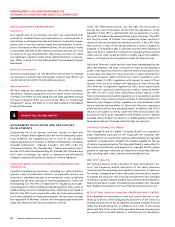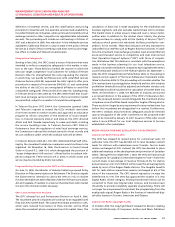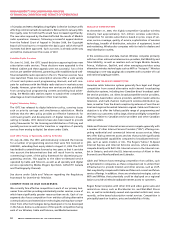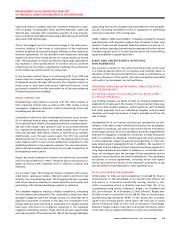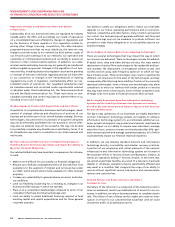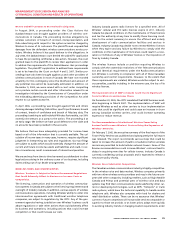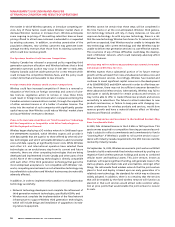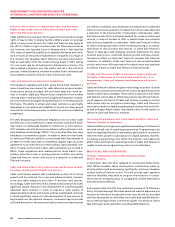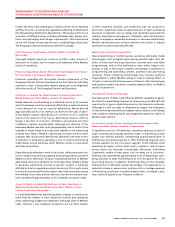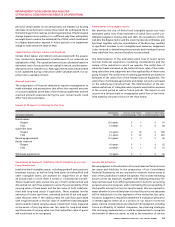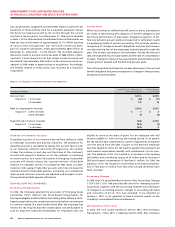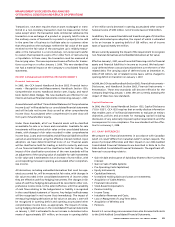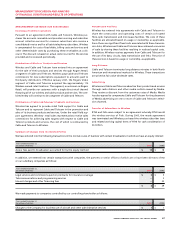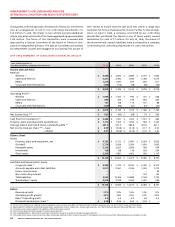Rogers 2006 Annual Report Download - page 62
Download and view the complete annual report
Please find page 62 of the 2006 Rogers annual report below. You can navigate through the pages in the report by either clicking on the pages listed below, or by using the keyword search tool below to find specific information within the annual report.
58 ROG E RS COM MUN I C ATIO NS I NC. 2 0 0 6 A N NUAL R EPO R T
MANAGEMENT’S DISCUSSION AND ANALYSIS
OF FINANCIAL CONDITION AND RESULTS OF OPERATIONS
Failure to Obtain Access to Suppor t Structures and Municipal
Rights of Way Could Increase Cable and Telecom’s Costs and
Adversely Affect Our Business.
Cable and Telecom requires access to support structures and municipal
rights of way in order to deploy facilities. Where access to municipal
rights of way cannot be secured, Cable and Telecom may apply to
the CRTC to obtain a right of access under the Telecommunications
Act. However, the Supreme Court of Canada ruled in 2003 that the
CRTC does not have the jurisdiction to establish the terms and condi-
tions of access to the poles of hydroelectric companies. As a result of
this decision, the Canadian Cable Telecommunications Association
filed an application with the Ontario Energy Board (“OEB”) asking
it to set a pole rate for all hydroelectric distributors in Ontario. The
OEB accepted jurisdiction over this matter and set a rate of $22.35
per pole. In New Brunswick, the New Brunswick Public Utilities Board
has accepted jurisdiction and set a rate of $18.00 per pole.
Cable and Telecom Face Substantial Com petition.
Technological, regulatory and public policy trends have resulted in a
more competitive environment for cable television service providers,
home phone service providers, ISPs and video sales and rental ser-
vices in Canada. Cable and Telecom faces competition from entities
utilizing other communications technologies and may face competi-
tion from other technologies being developed or to be developed in
the future. The ability to attract and retain customers is also highly
dependent on the quality and reliability of service provided, as well
as execution of business processes in relation to services provided by
competitors.
The CRTC Broadcasting Distribution Regulations do not allow Cable
and Telecom or its competitors to obtain exclusive contracts in build-
ings where it is technically feasible to install two or more systems.
CRTC winback rules also limit communications with customers in mul-
tiple dwelling unit buildings (“MDUs”) for ninety days after they have
switched to a competitive supplier. In addition, there are restrictions
on Cable and Telecom’s ability to communicate with the residents of
an MDU for ninety days after a competitive supplier signs an access
agreement to provide service in the building. Approximately one-
third of Cable and Telecom’s basic cable subscribers are located in
MDUs. These regulations and related policies could lead to com-
petitive subscriber losses or pricing pressure in MDUs serviced by
Cable and Telecom, which could result in a reduction in Cable and
Telecom’s revenue.
Cable and Telecom May Fail to Achieve Expec ted Revenue G rowth
from New and Advanced Produc t s and Services.
Cable and Telecom expects that a substantial portion of its future
growth will be achieved from new and advanced cable, Internet,
voice-over-cable telephony and other IP products and services.
Accordingly, Cable and Telecom has invested and continues to invest
significant capital resources in the development of a technologically
advanced cable network in order to support a wide variety of
advanced cable products and services and has invested and continues
to invest significant resources in the development of new services to
be provided over the network. However, consumers may not provide
sufficient demand for the enhanced cable products and services that
are offered. In addition, any initiatives to increase prices for Cable and
Telecom’s services may result in increased churn of our subscribers and
a reduction in the total number of subscribers. Alternatively, Cable
and Telecom may fail to anticipate demand for certain products and
services, or may not be able to offer or market these new products
and services successfully to subscribers. Cable and Telecom’s failure
to retain existing subscribers while increasing pricing or to attract
subscribers to new products and services, or Cable and Telecom’s
failure to keep pace with changing consumer preferences for cable
products and services, could slow revenue growth and have a mate-
rial adverse effect on Cable and Telecom’s business and financial
condition. In addition, Cable and Telecom’s discounted bundled
product and service offerings may fail to reduce churn and may have
an adverse impact on Cable and Telecom’s financial results.
If Cable and Telecom Is Unable to Develop o r Acquire Advanced
Enc ryption Technology to Prevent Unauthorized Acces s to Its
Programming , Cable and Telecom Could Experience a Decline in
Revenues.
Cable and Telecom utilizes encryption technology to protect its cable
signals from unauthorized access and to control programming access
based on subscription packages. There can be no assurance that Cable
and Telecom will be able to effectively prevent unauthorized decod-
ing of signals in the future. If Cable and Telecom is unable to control
cable access with our encryption technology, Cable and Telecom’s
subscription levels for digital programming including VOD and SVOD,
as well as Rogers Retail rentals, may decline, which could result in a
decline in Cable and Telecom’s revenues.
Inc reasing Programming Costs Could Adversely Affec t Cable and
Telecom’s Results of Operations.
Cable and Telecom’s single most significant purchasing commitment is
the total annual cost of acquiring programming. Programming costs
have increased significantly in recent years, particularly in connection
with the recent growth in subscriptions to digital specialty channels.
Increasing programming costs within the industry could adversely
affect Cable and Telecom’s operating results if Cable and Telecom is
unable to pass such programming costs on to its subscribers.
MEDIA RISKS AND UNCERTAINTIES
Changes in Regulatory Policies May Adversely Af fect
Media’s Business.
In December 2006, the CRTC released its Commercial Radio Policy
2006. While Canadian talent development contributions made by
all radio stations will be increasing significantly, minimum Canadian
content levels will remain at 35%. This will provide radio operators
with the flexibility they need to program their stations in compe-
tition with an increasing array of unregulated content alternatives
and distribution platforms.
In November 2006, the CRTC also conducted a review of its Television
Policy. Principal amongst the issues examined was the argument put
forward by television broadcasters that they should be provided
with the opportunity to collect fees from cable and satellite distribu-
tors for the carriage of their over-the-air signals. The ability to collect
fees will impact all broadcasters, including OMNI Television.


